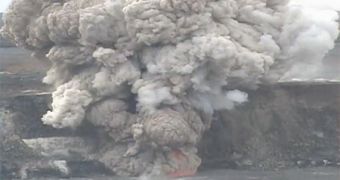Just two days ago, the volcano with the most relentless activity in the world erupted again. Instead of the lava spills which tended to become regular until this year, it was yet another powerful explosion. It is the latest in a series of such recent events, although not the largest.
One of the five volcanoes that make up the Hawaiian island, Kīlauea is the most active one in the whole world. It is located 19.42°N 155.29°W latitude, while its summit reaches 4.091 feet (1.247 meters) in height. On October 12th, it proved this once again with a mighty explosion of its Halema'uma'u pit crater, situated in its vast summit caldera (the cauldron-shaped surface formed as a result of the repeated eruptions that made the land collapse). The crater floor is situated 83 meters (270 feet) below Kīlauea caldera's floor and it's almost round, measuring 770 meters (2.530 ft) per 900 meters (2.950 feet).
A US Geological Survey camera captured the event closely, since its sudden beginning at 7:28 am. First, there was a large mushroom-like cloud of ash, soon followed by spews of hot gas and volcanic particles, covering the rim of the crater with a layer of ejecta the size of a fist. This sort of constant explosive eruption hasn't been reported for more than 80 years. The amount of tephra (the airborne material emitted by the eruption) was very high, though not the highest of this year (which was recorded on September 2nd), and also high are the sulfur dioxide levels emanated from both the Halema'uma'u and Pu'u 'O'o vents. Lava rivers follow their course towards the ocean to the west of Kalapana, the Hawaiian city destroyed and buried by Pu'u 'O'o's lava in 1990.
Researchers do not know for sure the nature and exact causes of the explosion, but, at the moment, they continue gathering data that would shed more light on the matter.

 14 DAY TRIAL //
14 DAY TRIAL //